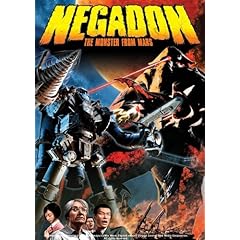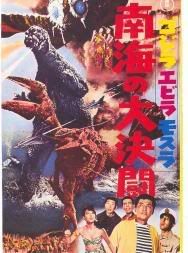 The 30-minute short film Negadon: Monster from Mars is another of the seeming flood of independently-made movies being produced by folks with a love of old monster movies. Some of these are outright, if affectionate, spoofs (Lost Skeleton of Cadavra, Destination: Mars), some are instead comparatively straight recreations (Stomp! Shout! Scream!). Negadon falls firmly into the latter category.
The 30-minute short film Negadon: Monster from Mars is another of the seeming flood of independently-made movies being produced by folks with a love of old monster movies. Some of these are outright, if affectionate, spoofs (Lost Skeleton of Cadavra, Destination: Mars), some are instead comparatively straight recreations (Stomp! Shout! Scream!). Negadon falls firmly into the latter category.
Made in Japan, Negadon is unsurprisingly a nod to the Toho giant monster movies of the classic “Showa” era, by which I mean the ’50s and ’60s. The extent to which this is true can be ascertained by looking at the poster/DVD box art, which copies the insanely busy and colorful poster art style employed by the Toho sci-fi movies of the ’50s and ’60s.
Referencing several of these, notably Atragon and (not to surprisingly) the original Godzilla, Negadon is set a couple of decades in the future. A terraforming mission to Mars reawakens a monster—sort of bio-mechanical beastie with range energy weapon capabilities—who comes to Japan to wreak the usual sort of havoc. There follows a pretty fun if predictably futile attempt by the military to deal with the situation.
Following in the footsteps of the previously referenced Atragon and Godzilla, the only hope for Mankind lies in a secret weapon held by a man who refuses to use it. In this case, the weapon isn’t a flying submarine or oxygen destroyer, but your classic giant robot (commanded, of course, from an interior compartment).
The man who controls this device is former industrialist Seiji Yoshizawa. There’s a reason for his decades’ long fall into abject despair, but why ruin it? In any case, he’s finally roused by this chance for redemption, and finally deploys his creation to stop the marauding invader.
Negadon’s most distinctive feature is that it’s entirely CGI. As usual, the humans don’t look as photorealistic as the rest of the show (including the monster and robot), which can be distracting. That said, the animation here is pretty amazingly good, include formerly problematic effects like rain showers and such. In the end, it’s a showcase for how much better and more accessible such technology is getting, with Negadon being the work of 11 people who spent 2 and a half years on it.
In other words, within 10 years, and maybe a lot sooner, we may indeed get to the point where a couple of people, or even one, with the proper level of enthusiasm and commitment, can craft themselves a pretty spectacular movie in their garage. At the other end of things, DVD and streaming Internet will provide the distribution mechanisms. This will be a boon for genre buffs, with films being made by people who love the same things, and aren’t constrained by the sort of compromises required by a film that needs to draw an audience of tens of millions of people. Random pixels are a lot cheaper than Tom Cruise.
Due to the short running time, the story is necessarily condensed. It probably could have been fleshed out a bit more, but on the other hand there’s nothing wrong with a piece that moves. Some might be disappointed by the comparative lack of screentime awarded to the monster and the robot, but what’s there is cherce. And even with animation, special effects-laden action scenes require more money and effort than scenes of two humans talking. Moreover, the monster stuff is pretty spectacular, and worth the wait.
In any case, any fan of giant monster movies should check this out, and for two reasons. First, because it’s good stuff and you’ll enjoy it. Second, because the amount of work and effort these guys put into this, along with the fact that they did a good job, deserves a half hour your time.
Negadon: Monster from Mars is available for rental from Netflix, or can be bought from the usual web vendors for around $12. The disc also features a pleasing array of ‘making of’ materials of those interested in such.

